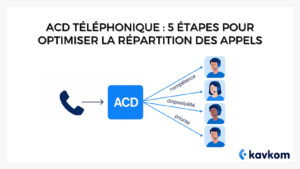What is IP telephony?
Familiar with PSTN, the telephone network that was heralded as revolutionary some forty years ago, modern businesses still sometimes find it hard to grasp IP telephony and its many advantages.
IP telephony: definition
Also known as VoIP (Voice over IP) telephony, this system has been around since 1995, and many professionals have already integrated this new technology into their business. The latter has become a standard and is becoming increasingly widespread.
In concrete terms, IP telephony is a method of efficiently routing all voice calls, using the telecommunications protocol, “IP” (Internet Protocol). This system also applies to :
- video files,
- confidential and non-confidential messages,
- fax.
But what is IP telephony in practice? To put it simply, the user’s voice (or any other compatible source) undergoes a technical process designed to digitize it. Transformed in this way into a multitude of digital data, voice is routed with much greater ease and clarity across the network, via the famous IP protocol.
Find out more about protocols used in IP telephony and their use cases see our dedicated article.
The benefits of VoIP telephony for businesses
This new technology offers many advantages, and is clearly a worthy successor to the old PSTN system, which is now tending to disappear.
- Lower costs
- Numerous functions
- Performance monitoring
- Mobility and flexibility
Discover the advantages of IP telephony in detail in our dedicated article.
IP telephony doesn’t require any compliance work, nor any investment in hardware or other equipment. It also eliminates the regular chore of maintenance work. Companies choosing IP telephony simply need a good Internet connection. Switchboards that have already taken this decisive step have evolved to become known as IPBXs.
How IP telephony works
By definition, IP telephony is based on the principle of digitizing voice via Internet protocols. These were developed to transmit digital signals over the network.
This technology can easily be compared to the famous “HTTP”. Its role is to select the best way to transfer the signals entrusted to it. Reception, transmission, formatting and distribution are its four main areas of activity.
The user’s voice is captured and analyzed. In so doing, it is transformed from an analog voice signal into transferable digital data. Once this transformation has been carried out, the data can travel across the network before being processed again on arrival.
Based on the same principle, the voice is analyzed, transformed once again and distributed to the second user. Although the process may seem complex, it’s perfectly mastered. In addition to optimum service quality, it also has the advantage of considerably reducing telecommunications costs.
To learn more about network types for IP telephony, bandwidth requirements and management, read our detailed article.
The different types of IP telephony
In terms of IP telephony, there are only two main types:
- IPBX,
- Centrex.
IPBX
When we talk about IPBX, we’re referring to a so-called “dedicated” infrastructure. For the company, this implies the presence of a telephone server, as well as quality hosting in the cloud.
In concrete terms, this choice has an impact on the company’s accounts. The IPBX is considered a fixed asset. The system can then be identified with an asset whose usefulness to the company is significant and long-lasting.
In return, the professional has full control over the entire system. Parameters can be customized at will, according to the company’s specific needs. Depending on the business sector, it’s essential to have this freedom within a switchboard.
Centrex
Centrex is a totally digitized version of the IPBX. Nothing happens within the company itself. The company’s switchboard is simply hosted elsewhere, by a trusted service provider.
For the professional, this choice frees up a considerable amount of time, simply because he or she is not responsible for setting up and managing the system. The service provider takes charge of this section, as well as all aspects of overall maintenance.
On a larger scale, decentralizing a switchboard can reduce overheads. It is possible, for example, to link several sites on the same server, that of the service provider. The costs can therefore be divided between each party.
How do you choose the right telephone solution?
First and foremost, companies need to take stock of their needs, in order to find the most appropriate solution:
- How much time can the company devote to setting up its switchboard?
- what is the overall budget for this item of expenditure?
- how many telephone sets are involved?
- what is the precise number of lines?
- How important is freedom of action for the company?
- what guarantees are required?
- what are the priorities: saving time, money, personalization?





